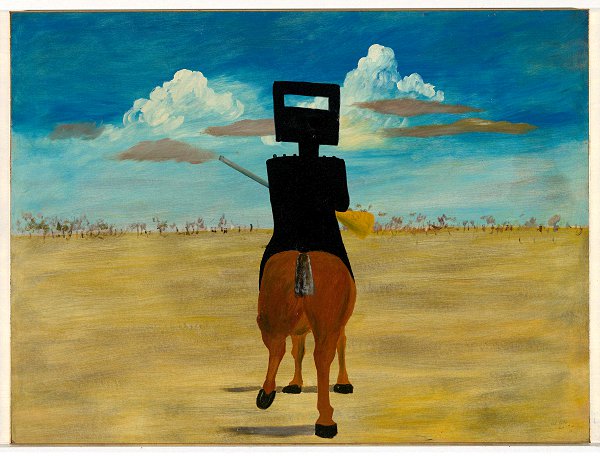SPONSORS Ernst and Young, Russell McVeagh, Telecom PUBLICATION Sidney Nolan's Ned Kelly publishers City Gallery Wellington; National Gallery of Australia, Canberra; essays Murray Bail, Andrew Sayers
Ned Kelly (1854–80) is a legend—an Australian national hero. The notorious bushranger-outlaw is remembered for his bullet-proof helmet and armour suit, made from plough mouldboards. He evaded police for two years in the outback, but was captured after a shootout in Glenrowan, tried, and hung.
Kelly is the subject of Sidney Nolan's Ned Kelly series (1946–7). Comprising twenty-seven stylised faux-naive paintings in Ripolin, a fast-drying enamel paint, the series is a breakthrough for the artist (begun while still in his twenties) and a defining moment in Australian modernism. Nolan's audacity (as an artist) is forever liked with that of his subject. He goes on to become a towering figure in Australian art.
The series depicts the violent events that lead up to Kelly's capture and trial. It begins with a scene-setter: an empty landscape lit by an eerie light from the horizon. The paintings progress through the main events of the story of Kelly and his gang: the shooting of constables at Stringybark Creek, the ensuing police chase, the activities of the police spy Aaron Sherrit, the siege of the hotel at Glenrowan, and the trial.
Nolan's Ned Kelly paintings capture the Australian outback, with its expansive planes, blinding sunlight, and skeletal trees. In 1961, Nolan says that the series’ main ingredients are ‘Kelly’s own words, and Rousseau, and sunlight’. In 1987, he says, 'It seems strange but when I painted the Kellys I thought of them as very angry, violent pictures and so did everyone else. Today they look quite tranquil … but still on target.’
The show is a coup for City Gallery. Since the series was gifted to National Gallery of Australia, Canberra, in 1977, it has only been exhibited abroad twice previously: at the Hayward Gallery, London, in 1988, and the Metropolitan Museum of Art, New York, in 1994.
Savage, tells the Dominion, ‘These paintings have only been allowed to go overseas once since they have been in the Australian national collection. They are so loved at home in Australia. I was aware we needed another level of advocacy and support which was why the assistance of the Prime Minister was crucial … New Zealanders will find echoes of conflicts and dramas from our own colonial past in these works.'
The story of how the show in Wellington happened generates as much media as the show itself. Prime Minister Helen Clark—as Minister for Arts, Culture, and Heritage—leads a delegation to Canberra with City Gallery Director Paula Savage, and Gillian and Roderick Deane. There, they meet Brian Kennedy, Director of the National Gallery of Australia. Clark reportedly says, like a highwayman, 'We have come about the Ned Kellys.’ Kennedy replies, ‘What could we say, only hand them over. I emphasise, however, it is a loan and we want them back!’
Clark continues, ‘The loan of the Ned Kelly series from the collection of the National Gallery of Australia represents an important cultural exchange between Australia and New Zealand providing New Zealanders with a rare opportunity to view these works in their own country. This exchange will open up future opportunities for our two countries.’
Clark tells the Evening Post, 'the paintings are iconic and humorous with a bit of a larrikin element. I looked for humour in them rather than bathos. There's always a streak in Australia of anti-authoritarianism and the Ned Kelly paintings tend to symbolise that.'
The press release explains, 'These works are remarkable for the way they have mythologised not only the Australian landscape but also its inhabitants—Irish immigrant, British colonial, and Aboriginal. Nolan's paintings explore themes of violence, love, folly, authority, and personal responsibility.'
The show is opened by Australian Governer-General Peter Hollingworth. His visit attracts media attention when parents of several Wellington schoolgirls refuse to let them sing at a welcoming ceremony at Government House. It’s alleged he helped conceal child abuse by clergymen during his term as Anglican Archbishop of Brisbane. The opening is followed by a state dinner at Government House, hosted by Dame Silvia and Peter Cartwright.
The Arts Festival hires The Neds, a pair of Australian stilt walkers, to dress as Kelly and stalk Wellington's streets and railway station to spruik the show. Local actor Brian Hotter is also employed to dress in armour as Ned Kelly to give tours of the show for sponsors and Friends of the Gallery.
In the Listener, art historian William McAloon writes, 'Nolan's quest—like that of his New Zealand contemporary Colin McCahon—was to invent a relationship to European modernism that made sense in a local context. His use of enamel paint somehow seems symbolic of this—a mix of French Ripolin and Australian Dulux.’
The show is presented as part of the 2002 New Zealand Festival alongside shows by Tracey Moffatt and Mikala Dwyer. Marketed as the Gallery’s Australian Art season, there’s one entry charge for all three: $7 adults, $5 concession, $3 kids.








